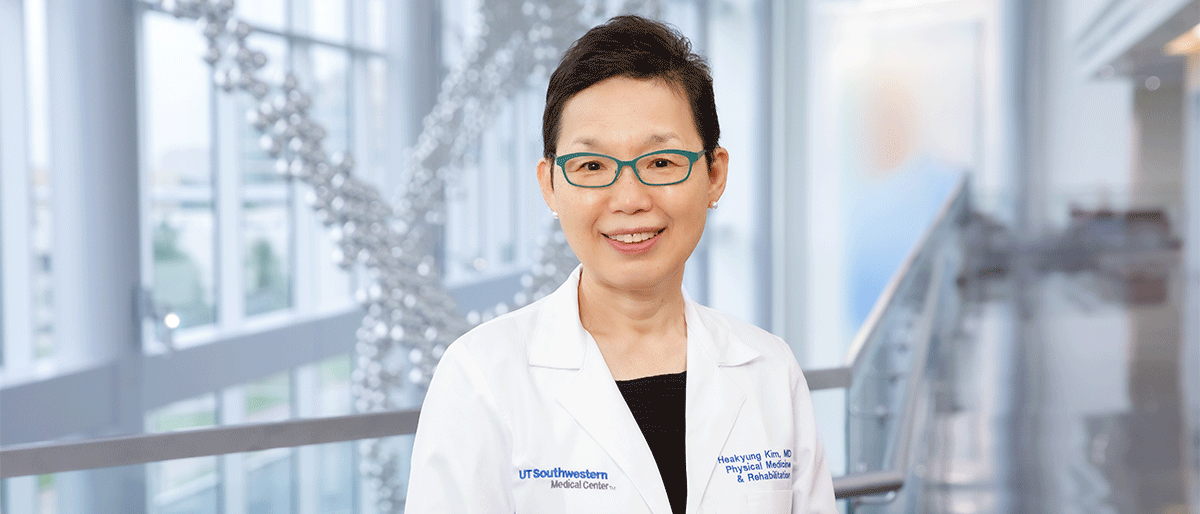Cerebral palsy specialist Kim appointed Chair of PM&R

Heakyung Kim, M.D., a physician-investigator known for research and treatment of cerebral palsy in children, has been appointed Professor and Chair of the Department of Physical Medicine and Rehabilitation (PM&R). Dr. Kim, who joined UTSW on May 1, holds the Kimberly-Clark Distinguished Chair in Mobility Research.
Dr. Kim came to UTSW from Columbia University Irving Medical Center, where she was Vice Chair and Professor of Rehabilitation, Pediatrics, and Orthopedic Surgery. She also served as Director of Pediatric Physical Medicine and Rehabilitation at New York-Presbyterian Morgan Stanley Children’s Hospital and was the founding Director of the Pediatric Rehabilitation Medicine Fellowship Program at Columbia University Irving Medical Center-New York Presbyterian Hospital.
As a clinician, Dr. Kim is considered an expert in a highly specialized procedure known as single-event multilevel chemoneurolysis (SEMLC) in which both botulinum toxin (also used in Botox) and phenol or concentrated alcohol are used to relax the stiff, weak muscles seen in cerebral palsy patients.
“Dr. Kim’s clinical expertise, research interests, and proven leadership record integrating physical medicine and rehabilitation in key areas of health care to improve patient care and increase efficiencies will further elevate our PM&R Department in clinical excellence and innovation,” said W. P. Andrew Lee, M.D., Executive Vice President for Academic Affairs, Provost, and Dean of UT Southwestern Medical School.
Dr. Kim received her medical degree from Ewha Womans University College of Medicine in Seoul, South Korea, and completed a fellowship in neuroscience and rehabilitation medicine at Yonsei University College of Medicine, also in Seoul. In the U.S., she completed a research fellowship in neuroscience at Rutgers Biomedical and Health Sciences in New Jersey, followed by a residency in combined pediatric and physical medicine and rehabilitation.
We spoke with the new Chair about her research, background, and plans for the PM&R Department.
What will be your main focus or goal as Chair?
I will be working to build a highly regarded and top-ranking PM&R Department that provides physiatrist-led, team-based, and patient-centered care, along with outstanding teaching, robust research, and specialized clinical programs.
What strategies will you use to achieve this goal?
First is education. We must have a strong residency program to be considered a top-ranking department. I seek to hire additional faculty to diversify the care we provide to the community, and to offer resources to our current faculty to bolster their practice. This will allow us to attract medical students who are dedicated to not only patient care, but to expanding medical knowledge through research. Second, we must build a well-developed research infrastructure that can consistently bring in funding via grants from organizations such as the National Institutes of Health (NIH). Third, and the backbone of medicine, is clinical work. By bringing in additional faculty, we can increase our community outreach and provide quality care to more people.
Can you describe some of your current research?
My clinical research currently focuses on spasticity management as well as pain in adults with cerebral palsy. Spastic muscles cause impairment of function, pain, and musculoskeletal complications. I have been working on efficacy of long-term care with SEMLC on children with cerebral palsy and pain management with botulinum toxin for adults with cerebral palsy.
I am involved in developing robotic therapy to improve ambulatory function in cerebral palsy patients. I sat down with engineers and discussed the problems these patients have walking, and they came up with a robot, the Tethered Pelvic Assist Device (TPAD), to improve muscle strength, balance, and gait.
I also research cognitive function in patients with cerebral palsy, who sometimes have intellectual disabilities as well. Right now, I’m conducting a pilot study that looks at an existing medication that may help cerebral palsy patients.
What motivated you to go into medicine?
I became a doctor because of my grandmother. She always wanted to have a child with an M.D. degree, but because of the Korean War during that time, none of her children could go for an M.D. When I went to medical school, I decided I wanted to be a rehab doctor to take care of people with special needs.
This appointment affords me the chance to expand PM&R’s presence in the medical community. It absolutely will help not only patients’ quality of life – by preventing unnecessary complications caused by being less mobile and promoting early detection and intervention of chronic and complex medical conditions – but will establish an ideal care model by a multidisciplinary team. I am so happy to have a leadership role to work on those goals.
Dr. Lee holds the Atticus James Gill, M.D. Chair in Medical Science.

